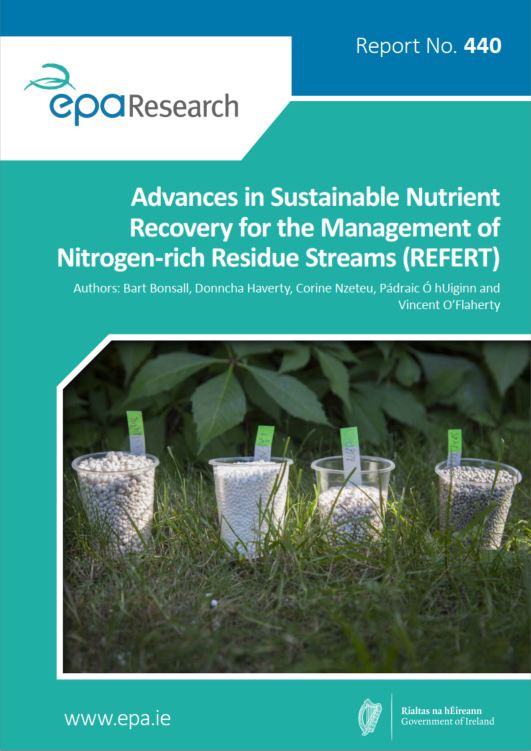Authors: Bart Bonsall, Donncha Haverty, Corine Nzeteu, Pádraic Ó hUiginn and Vincent O’Flaherty
Summary: Across the EU, anthropogenic sources of nitrogen (N) threaten water and air quality. Agriculture is also a significant source of N and GHG emissions linked to climate change. N for crops is sourced from mineral fertilisers, livestock manures and anaerobic digestion digestates. Landfill leachates also generate N and GHG emissions. The EPA funded this research to identify cost-effective methods to mitigate the release of N and GHGs from ammoniacal streams.

Across the EU, anthropogenic sources of nitrogen (N) threaten water and air quality, while greenhouse gas (GHG) emissions drive climate change.
Agriculture is a significant source of N and GHG emissions. N for crops is sourced from mineral fertilisers, livestock manures and anaerobic digestion digestates. Periodic application can result in nutrient concentrations that exceed the uptake capabilities of crops, leading to:
• N losses to surface or groundwater, leading to problems including eutrophication;
• ammonia emissions that contribute to fine particulate pollution and acid rain;
• the release of nitrous oxide, a potent GHG. GHG emissions also arise from fertiliser-related practices, for example:
• Mineral fertiliser production is a high-intensity source of GHG emissions.
• Livestock manures release the potent GHG methane during storage.
• Tractors generate transport-related GHGs. Other ammoniacal effluents, such as landfill leachates, also generate N and GHG emissions.
The aim of this project was to identify cost-effective methods to mitigate the release of N and GHGs from ammoniacal streams.
A community-based “hub and spoke” business model was proposed to aggregate slurries from the fragmented farm supply chain. Introduction of a sustainable nutrient certification scheme was proposed to engage farmers, remunerating them for supply of slurry for processing, consistent with new EU Common Agricultural Policy objectives. Implementation of a sustainable slurry management system is consistent with other EU and national policy objectives related to agriculture, the environment, energy, climate change and the economy.
The project concluded that this sustainable slurry management concept offered a route to improve the economic and environmental sustainability of agriculture. Validation of the potential benefits, however, requires further development of process technology, which to date has been undertaken only at prototype level. Integration of technology and business model concepts in a multi-cycle, end-to-end, commercialscale demonstration is required to validate economic and environmental assumptions and to determine acceptance among stakeholder groups. Development of regulatory roadmap(s) will be critical to allow for more comprehensive economic and impact assessments to be undertaken, and for progression of the proposed system towards full-scale application.
This project identified cost-effective methods to mitigate the release of N and GHGs from ammoniacal streams. The development of suitable technological solutions and a business model for their widespread adoption were both in the scope of the project.
Technological outcomes included:
• the demonstration of a scalable, modular treatment system;
• demonstrating that effluents could be treated to substantially reduce N, relative to current practices;
• demonstrating that solids could be conditioned to recover renewable energy;
• demonstrating that spent filter media and lime could be recovered as precursors to saleable soil-conditioning products;
• demonstrating that ammonia could be recovered as a precursor to a saleable fertiliser product.
The technology suite can be flexibly configured to deal with different ammoniacal effluents.
The project also identified a potential business model that:
• engages stakeholders by making it convenient and economical for farmers to participate in the slurry supply chain;
• uses technology for efficient aggregation of a widely dispersed slurry resource to achieve economies of scale;
• generates revenues from sales of productised fractions that can be applied to offset processing costs, required to underpin economic viability;
• is readily replicated, promoting commercialisation and progress towards sustainability objectives
https://www.epa.ie/media/epa-2020/research/research-publications/Report-Cover-Image-440.png